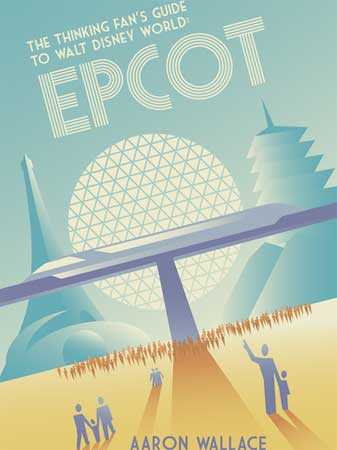EPCOT Center is what made me a Disney World fan, and this site wouldn’t exist without it. I remain fascinated by the original pavilions and the park’s huge ambitions. There was nothing else like it. Described as a “permanent World’s Fair”, EPCOT Center had many similarities to those grand events but also felt unique. There was a cool symmetry among the pavilions in Future World and World Showcase. Sadly, we’ve lost much of that today. Even so, there’s still plenty to enjoy at Epcot. In his new book The Thinking Fan’s Guide to Walt Disney World: Epcot, Aaron Wallace captures what keeps fans coming back to the park today.
It’s tricky to give today’s Epcot a fair shake, especially when you dive into Future World pavilions like Imagination!, Ellen’s Energy Adventure, and the Seas with Nemo and Friends. Wallace does a good job spotlighting the issues without making the chapters too negative. It’s rare to read such a fair assessment of Epcot’s less heralded attractions. Most chapters are between six and eight pages, and that space gives Wallace the chance to dig beneath the surface. He does more than just give the typical overview and a few quick opinions. Instead, each chapter offers a surprisingly nuanced take on every aspect of the attraction.
In particular, the Journey into Imagination with Figment chapter offers an excellent look at the evolution of that once-beloved pavilion. Wallace describes the strange message of Dr. Nigel Channing, who wants to put imagination into a box. Citing a point by Foxxfur of Passport to Dreams Old & New, he connects the attraction’s history to the message spouted by Channing. I hadn’t considered that frustrated Imagineers may have inserted a few hidden messages into the ride about its lost creativity. Regardless of whether that’s true, it is a fascinating way to look at the current version. Setting imagination free is what Disney needs to do across Future World.
Despite being called the “Thinking Fan’s Guide”, this book has a down-to-earth style. Wallace recognizes that not every reader will want to dive into the academic concepts behind the attractions. He finds a way to balance the intellectual concepts with more straightforward thoughts on the rides. I did enjoy when he went further and expanded the discussion, however. A great example was the section on the Predominant Thrust Test, which stems from contract law. Wallace applies that concept to World Showcase pavilions, and it doesn’t feel like a stretch. It’s a clever way to discuss the idea of characters in World Showcase, particularly in Norway with its Frozen arrivals. I enjoyed how Wallace found a new way to cover the controversial issue.
Wallace closes out each chapter by connecting the attraction thematically to a film or TV show. It’s an engaging device that can expand our outlook on the key issues, particularly with Future World. He cites Disney short films like Exploring the Reef for The Seas with Nemo & Friends, vintage TV episodes like “Our Friend the Atom” for Ellen’s Energy Adventure, and even the wonderful TV series Reading Rainbow for Test Track. The picks are rarely the most obvious choices, and some are even brand new for me. These inclusions help make this book more of a reference guide and not just an interesting way to pass the time.
The Thinking Fan’s Guide to Disney World: Epcot is nearly 230 pages, which is quite hefty for a book that only focuses on attractions at a single park. There are actually 45 pages of notes at the end, which are essential to give the research behind Wallace’s thoughts. This section does a lot more than just cite the resources and includes quite a bit of commentary too. Don’t skip this part. Wallace also provides a solid index and an appendix to discuss key fan questions like “Who Narrated Spaceship Earth?”. There’s a wealth of great material packed into these pages.
It’s easy to get discouraged when looking at recent developments (or lack thereof) at Epcot. I like Test Track and Soarin’, but the park isn’t on the same level as its heyday from the ‘80s and early ‘90s. Wallace’s book offers a good reminder of the treasures that are still present in modern Epcot. It’s also an optimistic book that identifies opportunities for improvement across the park. The foundation remains for something amazing, but management has to care about making Epcot better. I’m not convinced we’ll see positive updates, but you never know. Disney can still surprise me (Rivers of Light, Pandora) when they put their minds to something. Epcot needs that same level of attention to again become an incredible theme park. Let’s make this happen.
This post contains affiliate links. Making any purchase through those links supports this site. See full disclosure.




Very cool, added to Amazon wishlist! Thanks for the recommendation!
No problem! It’s definitely worth checking out, especially if you’re interested in Epcot.